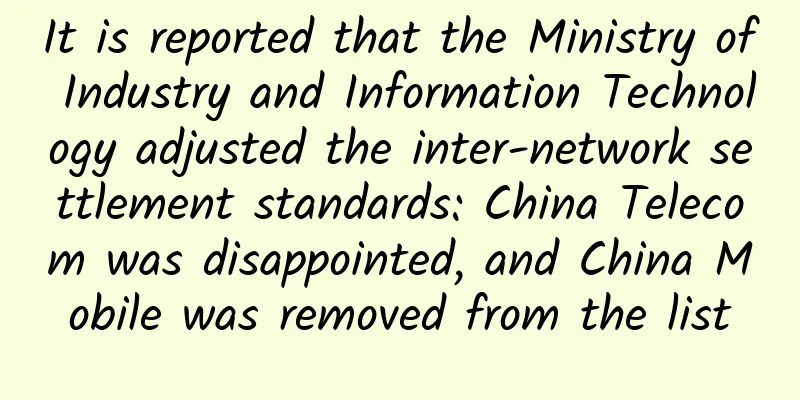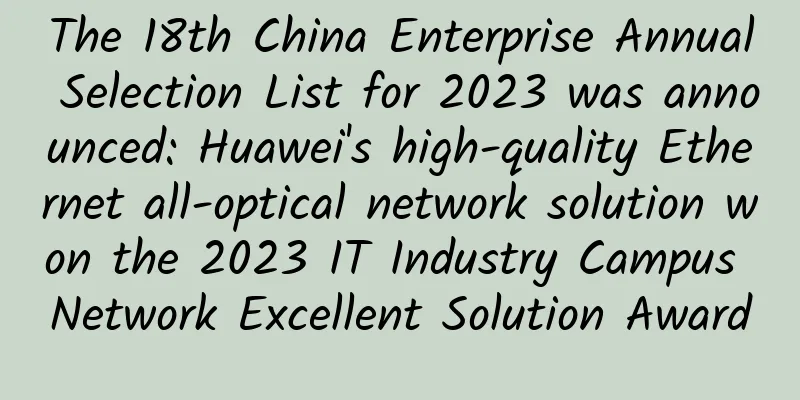It is reported that the Ministry of Industry and Information Technology adjusted the inter-network settlement standards: China Telecom was disappointed, and China Mobile was removed from the list

|
According to online reports, the Ministry of Industry and Information Technology has issued a notice on adjusting the inter-network settlement policy of the Internet backbone network. The document points out that in order to thoroughly implement the strategy of building a strong network, build a scientific and reasonable inter-network settlement relationship, accelerate the construction of network facilities and speed up and reduce fees, and promote the development of my country's Internet industry and digital economy, after in-depth research and demonstration, the inter-network settlement policy of my country's Internet backbone network has been adjusted. As soon as the news came out, it attracted widespread attention and discussion in the industry.
Involving multiple policy adjustments First, from July 1, 2020, the one-way settlement policy between China Mobile, China Telecom and China Unicom will be cancelled, and peer-to-peer interconnection will be implemented without mutual settlement. Before July 1, the existing inter-network settlement policy and settlement standards will be maintained, that is, China Mobile should pay the Internet backbone network inter-network settlement fee to China Telecom and China Unicom, and the settlement standard shall not exceed 80,000/G/month. Second, in order to support new market entrants, stimulate market vitality and promote the overall high-quality development of the industry, starting from January 1, 2020, China Telecom, China Mobile and China Unicom will reduce their settlement fees to China Broadcasting Corporation and CITIC Network, with the reduction ratio no less than 30% of the current standard settlement price (80,000/G/month). Third, starting from January 1, 2020, free interconnection will be implemented between public welfare networks such as the Education Network, Science and Technology Network, Economic and Trade Network, and the Great Wall Network and the Internet backbone networks of China Telecom, China Mobile and China Unicom. Fourth, all Internet backbone network interconnection units should strictly abide by relevant laws and regulations, and must not use third-party illegal bandwidth resources for network interconnection, and ensure that the inter-network routing of each backbone network is configured in compliance with regulations. Fifth, public welfare network interconnection units such as the China Education and Research Computer Network Network Center, the Chinese Academy of Sciences Computer Network Information Center, the China International Electronic Commerce Center, and the China Great Wall Internet Network Center should strictly abide by the principle of "dedicated network for dedicated use" and must not use public welfare network resources to illegally engage in telecommunications business operations. Sixth, we will implement a supervision and management mechanism with network quality as the core, and in accordance with the "Internet Backbone Network Communication Quality Supervision and Management Measures", we will increase the coordination and resolution of network expansion disputes. For interconnected units that violate the regulations, we will implement reminders, supervision, interviews, warnings, administrative penalties, etc. in accordance with the law to ensure smooth communication between networks. Which companies will benefit? After the policy was released, the most discussed issue was who would benefit and who would lose some income. Obviously, China Telecom and China Unicom, which traditionally collect network settlement fees, will inevitably lose a large amount of income. In the short term, the most direct beneficiary of this policy is undoubtedly China Mobile. Unlike the inter-network settlement of voice and SMS, the inter-network settlement of the backbone Internet between China Mobile and China Telecom and China Unicom has always been one-way, which means that China Mobile users need to pay the corresponding fees for the bandwidth generated by accessing the content and services in the data centers of China Telecom and China Unicom. It should be noted that the early IDC resources were basically in the hands of China Telecom and China Unicom. According to China Mobile's current user base, this is a considerable expense. On the contrary, for China Telecom and China Unicom, this is a considerable income, so some people jokingly say that this is directly snatching a piece of meat from China Telecom and China Unicom. At the same time, after peer-to-peer interconnection and no mutual settlement, China Mobile got rid of the hat of "secondary operator" that had been forced on its head for many years. Of course, the most fundamental reason why China Mobile can reap this policy is that the user volume has formed a scale. As of January 2020, China Mobile's mobile user base has reached 949.415 million, and the number of fixed broadband users has reached 188.271 million, requiring peer-to-peer interconnection to meet user needs. In addition, with China Mobile's investment in IDC resources at all costs in recent years, and the obvious results of its investment in backbone network bandwidth, the scale of the network has continued to expand, and it has sufficient volume and capital to be interconnected with China Telecom and China Unicom. In addition, for China Radio and Television, the user base of China Radio and Television has always been relatively small, the network scale is small, and the operating entities are also scattered, basically one operating entity per province. In order to meet the needs of this small number of users, it must pay inter-network settlement fees to the three traditional operators. With the explosive growth of traffic today, this is a considerable expense, so China Radio and Television has always hoped to obtain policy support in inter-network settlement. Although it did not receive the same treatment as China Mobile this time, it also received certain policy benefits, which is more conducive to its future 5G development. However, in my opinion, the biggest beneficiary of this policy adjustment is CITIC Network. CITIC Network's backbone network resources are different from those of the other companies. Its target market is the 2B market, and its potential customers are also CSPs (cloud service providers), industries and corporate users, and these users have a greater demand for bandwidth than individual users. Last year, the Ministry of Industry and Information Technology issued a new basic telecommunications business license to CITIC Network, allowing CITIC Network to engage in domestic Internet data transmission business. Coupled with the support of this inter-network settlement fee policy, it is even more powerful. In the long run, to some extent, according to CITIC Network's understanding of the market needs of government and enterprise customers better than the three major operators, it will have a certain impact on the three major operators in the government and enterprise market. Of course, ordinary consumers are the ultimate beneficiaries. On the one hand, after China Mobile, China Telecom and China Unicom achieve peer-to-peer interconnection, reducing the inter-network settlement process will improve user experience to a certain extent; on the other hand, whether it is canceling the inter-network settlement fee or reducing the inter-network settlement fee, it may bring some room for fee reduction. |
>>: Edge computing vs. cloud computing: Which is more efficient?
Recommend
From concept to practice, the trend of blockchain is coming
In accordance with the requirements of blockchain...
SD-WAN is about to dominate edge networks
Network transmission is like playing a team battl...
Ruijie Networks: Continue to Lead, "Our Journey Is to the Stars and the Sea"
[51CTO.com original article] As cloud desktop tec...
50% of CIO panel members predict that 5G will drive the development of the Internet of Things
A panel of 12 technology experts (also known as t...
[6.18] TmhHost: 20% off on CN2 GIA/high-defense cloud servers in Hong Kong/Japan/USA, starting at 35 yuan per month for CN2 in Japan
TmhHost is a Chinese hosting company founded in 2...
One million new 5G base stations will be built next year. Is that a lot?
The latest news shows that my country has built a...
Wholesaleinternet: $25/month-E3-1230v2/32GB/480G SSD/1Gbps unlimited traffic/Kansas data center
In addition to the cheap dedicated servers that w...
Three trends driving cyberattacks in 2024
Ransomware claim activity is set to grow more tha...
[Black Friday] DMIT consumption rebate, 20% off Japan VPS, 50% free traffic in Hong Kong/Los Angeles
DMIT.io also launched a promotion during Black Fr...
Summary information: CUBECLOUD/Duoxiantong/CYUN/PIGYun/Ouluyun/VoLLcloud/Hongsu Technology
July and August are the summer vacations, and man...
What is in the Http Header?
The author has developed a simple, stable, and sc...
5G may be just around the corner as a universal core for fiber
Convergence between wired and wireless networks i...
In addition to base stations, what else should major cities pay attention to in 5G construction?
It has been a year since 5G was officially put in...
Justg: Russia CN2 GIA line VPS is online with annual payment starting from US$39.99
Last year, the blog shared the news of Justg'...





![[11.11] CloudCone: $11.11/year KVM-1GB/40GB/2TB/Los Angeles Data Center](/upload/images/67cac24ccb753.webp)



